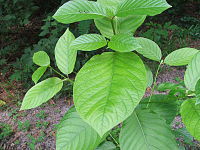
Photo from wikipedia
Abstract Context: Kratom, or Mitragyna speciosa, is a plant indigenous to Southeast Asia that has gained national attention in the United States for its increased use in the self-management of… Click to show full abstract
Abstract Context: Kratom, or Mitragyna speciosa, is a plant indigenous to Southeast Asia that has gained national attention in the United States for its increased use in the self-management of opioid withdrawal and pain, as well as for concerns about its safety. Methods: This study analyzes exposures to kratom reported to poison control centers (PCCs) in the United States during 2011–2017 from the National Poison Data System (NPDS). Discussion: From 2011 through 2017, 1807 kratom exposures were reported to United States PCCs. Almost two-thirds (65.0%) of these exposures occurred during 2016–2017. Most exposures occurred among adults ≥20 years (88.9%), males (70.8%), at a residence (86.1%), and were intentional (74.3%). Among first-ranked kratom exposures, 31.8% resulted in admission to a health care facility (HCF) and 51.9% in a serious medical outcome. Multiple-substance exposures were associated with greater odds of admission to a HCF (OR: 2.80; 95% CI: 2.21–3.55) and a serious medical outcome (OR: 2.25; 95% CI: 1.77–2.85) compared with single-substance exposures. There were 11 deaths associated with kratom exposure, including two that occurred after exposure to kratom only. Among kratom-only exposures, 86.1% resulted in one or more clinical effects. The most common clinical effects were agitation/irritability (22.9%) and tachycardia (21.4%). There were seven neonatal exposures, including five experiencing withdrawal. Conclusions: Kratom is associated with a variety of serious medical outcomes, especially when used with other substances. More research is needed to define the human response to kratom. Increased regulation of kratom products would help guarantee product quality and safety. Individuals who choose to use kratom should be educated about its potential risks, including the dangers of using it in combination with other substances.
Journal Title: Clinical Toxicology
Year Published: 2019
Link to full text (if available)
Share on Social Media: Sign Up to like & get
recommendations!